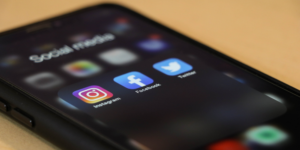Let’s start at the very beginning: social media is perfect for lead generation. If you’re looking for high-scoring leads that fall squarely within your market, then look no further. True, it may be more closely associated with B2C customers, but B2B execs and buyers aren’t operating in a vacuum where the power of thought leadership and share of voice no longer matter.
In some ways, they matter more for B2B.
Too often, we equate social media with customer management. It’s understandable why. Most of a brand’s followers will be their existing customer base – as are the lion’s share of interactions, tags, mentions, and comments, after all.
But that’s not to say that your socials can’t play a pivotal role in lead gen. In fact, when handled right, a social media strategy can be predominantly focused toward making moves into untapped areas of a particular market, cultivating leads, and moving them into the inbound marketing funnel.
That’s the very fundamentals out of the way. Here’s everything else you need to know about lead generation through social media publishing.
Jump to Section
What Do We Mean By Social Selling?
Social selling is just another way of referring to the use of social media to find, cultivate, and convert leads. It’s the practice of leveraging social media’s full potential to boost sales, coordinating the two separate powers of your marketing and sales teams in the process.
It’s also a great antidote to the ad fatigue that we’re all familiar with – both as customers, and as marketers. By some estimates, the average American is exposed to between 4,000 and 10,000 ads every single day. Yep – every single day of the year. It’s no surprise that customers (and MarOps) are looking for more meaningful ways of spreading brand awareness and attracting new customers.
Social selling depends on your ability to publish quality content and really engage an online community. For that reason, it’s an incredibly rewarding practice. In terms of realizing the almost-to-good-to-be-true ROI promised by social media, this is the holy grail, and it’s not as difficult to manage within your existing marketing team as you might think.
First, you’ve got to know where your efforts should be focused – what falls under the scope of your social media marketing strategy. Next, you’ll want to get your head around the key strategies for lead generation on social media – and how to make that work without tripling the size of your marketing team.
This is where B2B and B2C start to differ – but only slightly. While the strongest platform for B2C companies remains Facebook (followed closely by Instagram), the strongest for B2B social selling is LinkedIn. With 65 million members considered business decision-makers, nowhere else online is currently able to rival LinkedIn in terms of its scope for lead generation.
The platform lends itself to B2B thought leadership. It’s headlined by a number of key voices who have risen to the top – but, beneath that, the pyramid is filled with micro-influencers who have cultivated niche followings – some of which will be the perfect match for your brand.
But LinkedIn isn’t the only platform that is perfect for B2B lead generation. Some of the most prominent social channels – Facebook, Twitter, TikTok, YouTube, and Instagram have proven themselves to be ideal for lead generation and improving existing customer relationships. It’s all about tailoring your social publishing approach to the various channels – responding to audience insights as and when they arise – and creating and publishing content for lead generation consistently.
The Fundamentals of Social Selling
Content publishing
This is the backbone of social selling. Without it, your social media presence is…well…non-existent.
The greatest power social selling offers B2B enterprises is engagement. Consider the difference between a lead that has already engaged with your brand – a lead that already knows what you can offer not just in terms of your products/services, but in terms of expertise, passion, market understanding and strength of customer service – and a lead that has merely clicked on an ad or opened an email. One is halfway down the funnel already, while the other is still dangling their legs over the top.
If you’re qualifying leads against key criteria, then leads generated through inbound marketing already have the edge. When they’ve engaged with your social media channels – and you’ve been able to respond in real-time thanks to a good social listening strategy – you’re onto a real winner.
But, when it comes to omnichannel marketing, any MarOp knows that content creation has to be nuanced. Long gone are there days when we could copy + paste between social channels, email, and other publishing platforms.
Instagram emphasizes photo and video content (in more or less equal measure) over lengthy posts, whereas LinkedIn is the ideal platform for more absorbing articles and thought-provoking pieces. YouTube is the perfect platform for long-form video content, while TikTok favors that same content trimmed down to bitesize pieces and key points.
With the right content repurposing strategy, it’s easy to make your content work for an omnichannel approach without creating everything from scratch (or simply echoing yourself across each channel). Similarly, integrating plenty of user-generated content – particularly testimonials – is a simple tactic with a high ROI, given the importance UGC holds for decision-makers.
But how do you know what content to create and, just as importantly, when to publish it?
Social Listening
If content creation is the backbone, then social listening is the calcium.
We’re not mind-readers. We can’t wake up one morning, roll up to the desk, and start writing exactly what thousands of people woke up wanting to read. Sure, every so often you might just strike gold but, like the chimpanzees trying to write Shakespeare, any success is really just a fluke.
But social media has evolved into their own ecosystems. Trends are constantly rising and falling, redirecting creators this way and that, determining whether a good piece of content is going to engage viewers or just slip by unannounced. What’s a marketer to do?
Social listening – the practice of keeping one ear tuned into the changing tides on LinkedIn, Instagram, Facebook, Twitter, and any other platform you choose to build a presence on, as well as your competitors and, of course, your target audience.
From tracking keywords to specific brand mentions, influencers to competitors, you can be ready at a moment’s notice to position yourself center stage.
Your ability to react depends on you having a healthy store of content that can be published as and when it’s needed but, with the right social media management platform automating the more time-consuming parts of marketing on these channels, your hands will be free to create content in batches, ahead of time.
Automation
How you structure your approach to social media management is just as important what you do on social media. Why? Because it can either be the most scalable marketing tool you have in your arsenal, or the biggest drain on your time, energy, resources, and sanity.
Marketing automation is what makes social media scalable. Using AI-powered tools to schedule and plan your social media posts, handle social listening in real-time on your behalf, repurpose and edit content to avoid repetition and boost engagement, and review and publish analytics streamlines the process of managing multiple social media channels, and allows you to focus on what’s important: lead nurturing, and continuing to create content for lead generation.
At Oktopost, we’ve embraced AI for exactly these purposes. Features like our Post Wizard, for modifying content (not just in length, but in tone, too), and our message mixer mean you don’t need to take your eye off the ball just to carry out your strategy.
Community Management
Social media isn’t just there for generating leads and getting them into the funnel. It can (and should) be leveraged for every stage in the process – for the awareness stage, consideration, decision-making and, after that, for maintaining engagement and loyalty among your customers.
Again, it’s all about streamlining, automating, and centralizing. Handling community management from a central platform makes everything instantly manageable. It means you can retarget existing customers while also generating fresh new leads. Getting to grips with automation and lead scoring is fundamental to learning how to nurture leads through social media. It all goes hand-in-hand.
Harnessing the Power of Social Media Lead Generation
Social selling is all about building your presence on public platforms. Compared with other forms of digital advertising, it enables you to reach customers and prospects in a way that feels far more authentic and, for that reason alone, far more engaging.
If you can get your strategy just right, then it will serve you in more ways than one. From finding leads to lead nurturing and ongoing community management, the various social media channels offer the perfect platforms for boosting ROI from inbound marketing, and getting the most valuable leads moving through your funnel.
Not to brag, but that’s exactly what we’re experts at. Here at Oktopost, it’s all about leveraging the best in AI and automation to streamline social selling and deliver you the strongest ROI possible from the social publishing platforms you take on.




![Read more about the article [Funding alert] Hyderabad-based agritech startup Our Food raises $6M](https://blog.digitalsevaa.com/wp-content/uploads/2022/01/agritech-1590421634963-300x150.png)





